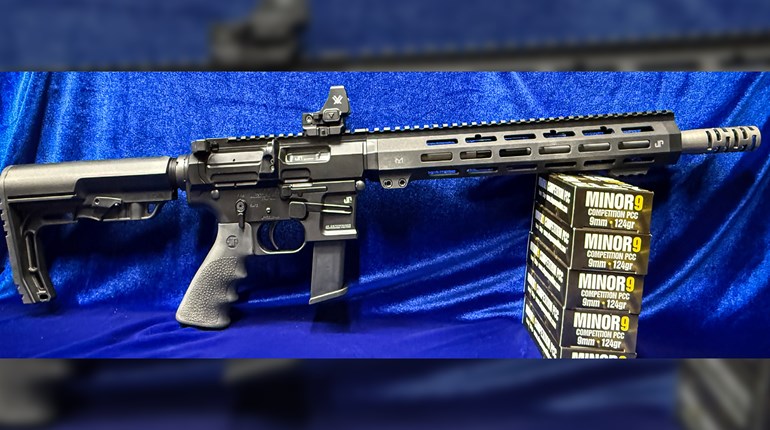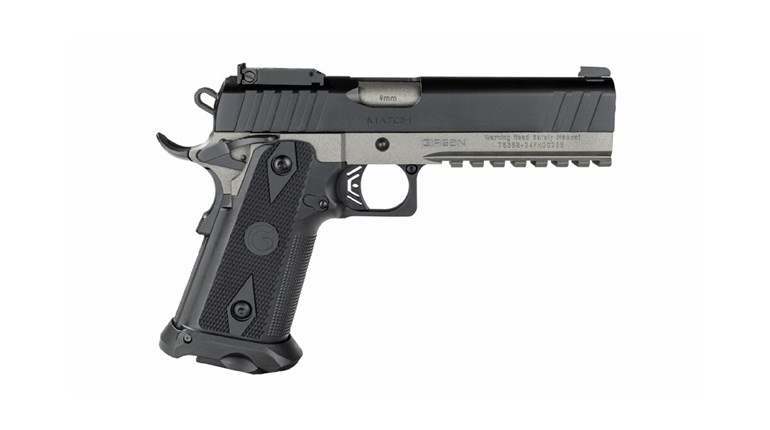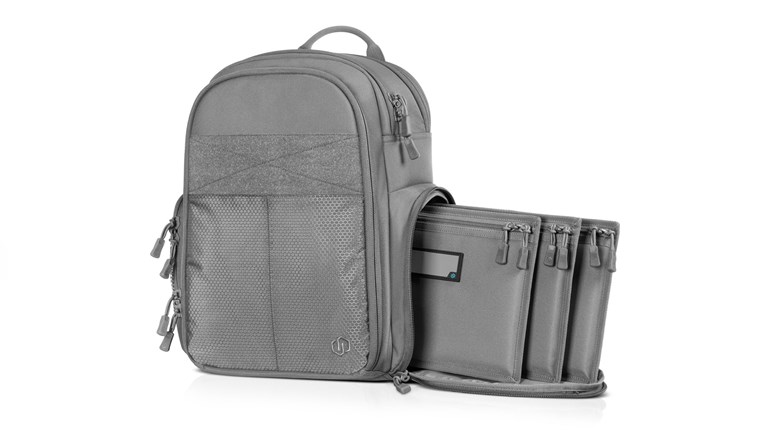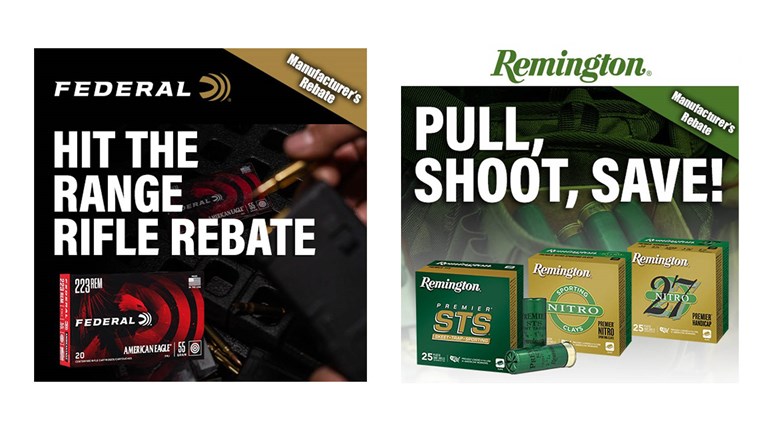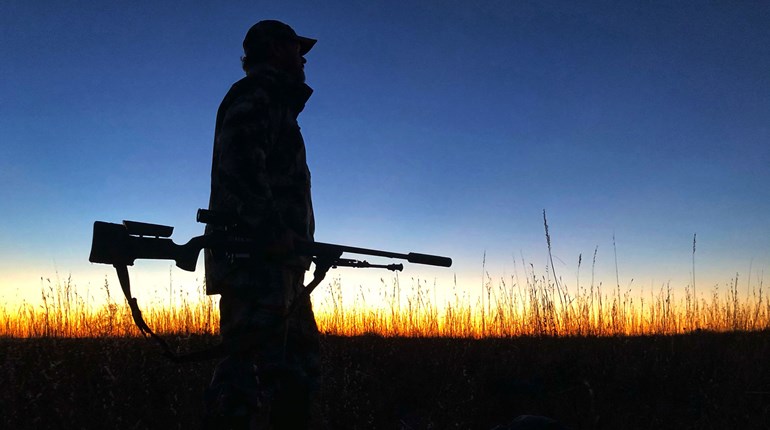
In recent months, I've been exploring the performance and handling of the evolving Poly Tuffy series of compact, single-shot firearms from Rossi. A few years ago, the break-action Tuffy line up was updated. The changes included the replacement of the all-steel receiver with a polymer receiver molded around a one-piece steel trunnion. This mixed-material Poly Tuffy receiver is significantly lighter while still utilizing steel at key support points, including the breech face and the barrel's hinge. Last year, I took the dedicated .410 Bore shotgun version for a test drive (see the full report here).
At the beginning of 2024, the company took this series in a fresh direction with the release of the Brawler single-shot pistol. Built around the same polymer receiver, its 9-inch barrel is configured to fire .45 Colt revolver cartridges along with 2.5-inch and 3-inch .410 Bore shotgun shells. Outfitted with an optics rail and a hand filling rubber grip, it proved to be a hoot to shoot (see the range results here).

With the launch of the Brawler, Rossi had most of the elements in place for a dual-caliber long gun model already sorted out. So, it was not too much of a surprise when the new Rossi Poly Tuffy Survival .45 Colt/.410 Bore gun was announced. Having worked with the preceding models, I was curious to give the Survival model a try.
The vast majority of design cues for the .45-caliber Survival have been lifted directly from the dedicated .410 Bore Poly Tuffy long gun. The polymer receiver with its integral trigger guard, steel bow trigger, push-button cross bolt safety, exposed hammer and right-side barrel release lever are the same. This gun uses a single-action trigger design, meaning the hammer must be manually cocked for each shot fired. A transfer bar safety ensures that the gun will not fire if the hammer is bumped or the gun dropped. In this case, the smooth, clean trigger pull weighed in at 3-pounds 15-ounces, making it about half a pound lighter than the other two models I've worked with.

The Survival sports the Tuffy shotguns' polymer furniture set. However it is only available in black.
A small but useful change was made to the textured fore-end's sling swivel stud. Unlike the shotguns, it has a knurled knob which makes it easier to loosen when removing the forend and barrel from the receiver. It's a nice touch when splitting the gun in half to fit it into a backpack or more compact storage space. It should be a feature for all Tuffy models.
The lightweight stock is a great fit for this gun's intended purpose. The length-of-pull (LOP) is a noticeably Hobbit-sized 11.5 inches, but the rubber recoil pad and thumb-hole pistol grip make it more manageable to work with. Both sides of the stock are fitted with four round shell holders, which will comfortably accommodate the cartridges this gun fires, and a rear sling swivel stud is installed at the factory. I just wish they would finish off the outdoor survival package by providing some sort of cap or plug for the hollow pistol grip. That way it could be used as a storage space for small survival items like fishing line, waterproof matches, etc.

The key changes that differentiate this Survival model from the shotguns lie in the sight system and the barrel configuration. The brass-bead front sight has been replaced with a removable rifle-style polymer blade. A simple, but clever, solution for providing a square-notch rear sight is a small polymer insert set into a 4-inch long, 10-slot aluminum Picatinny rail. This setup allows the gun to be used with the iron sights, right out of the box, or it can support a wide variety of today's popular red-dot optics.
The round-profile 16-inch barrel has been beefed up to accommodate .45 Colt revolver cartridges. This gives the gun an unloaded weight of 3 pounds 11.5 ounces, which is 13-ounces heavier than the dedicated .410-bore model. The barrel's chamber is fitted with an ejector that vigorously launches spent .45 Colt and .410-bore cases over the shoulder of the shooter. Stick with standard pressure .45 Colt loads. If you do come across ammunition marked .45 Colt +P, do not fire it from this gun. The +P loads can generate significantly higher levels of pressure—potentially in the .44 Magnum to nearly the.454 Casull range—which is far more pressure than this gun was designed to handle.

This model's muzzle is threaded for the two removable choke tubes shipped with the gun. A choke wrench is also provided. As the owner's manual shows, the tubes are twisted to the left (counter-clockwise) to tighten them into the muzzle and to the right (clockwise) to loosen them for removal. But it should be noted here that these tubes are not chokes in the traditional shotgun sense. They serve two other purposes. One tube has a smooth interior, much like a Cylinder Bore choke. It is, in essence, a thread protector for use when shooting .45 Colt cartridges. It does nothing to affect the performance or patterns of any of the ammunition fired.

The second tube's interior features six-groove, straight-profile rifling. It is intended for use with the .410 Bore buckshot and birdshot loads. I saw this type of rifled choke for the first time years ago when testing a Magnum Research BFR revolver chambered for .45 Colt/.410, and then again when working with the Rossi Circuit Judge revolver carbine, also chambered in .45 Colt/.410 bore. The purpose of the straight-rifled choke is not to constrict the bore. Instead, it is intended to reduce the spin of the shot loads caused by the barrel's .45 Colt-sized rifling. As the range tests showed, using the rifled tube with the shot shells did tighten up the patterns a bit. But do not use the rifled choke with .45 Colt, because doing so is likely to damage the gun.
Having worked with a variety of .45 Colt/.410-bore handguns and long guns over the years, I've found that these dual-caliber platforms come with certain performance advantages and trade-offs. The benefit of this configuration is ammunition flexibility. One gun can safely chamber and fire typical .45 Colt cartridges and .45 Colt snake-shot loads, along with 2.5-inch and 3-inch .410-bore shells filled with birdshot, buckshot and mixed-projectile payloads. That's an impressive range of options.

However, the features that work to support one type of ammunition can work against the performance of the other. As mentioned earlier, the .410 Bore shot loads will pick up a spin from the rifled bore. This causes the shot pellets to spread much more quickly then when they are fired from a smooth-bore barrel. As for the .45 Colt, the rounds are fired through a chamber sized for 3-inch .410-bore shells. This means the bullets travels through roughly 1.45-inches worth of un-rifled chamber before engaging the rifling of the barrel's bore. This in turn affects the bullet's accuracy potential since it has a relatively long time to pick up a shimmy before it’s stabilized. Simply stated, a dedicated .45 Colt-only handgun or long gun is almost always going to yield better accuracy results than a .45 Colt/.410-bore platform.

For all informal and formal testing of the Survival model, I took advantage of the rail to mount a red-dot optic. This single-shot rifle has a budget friendly suggested retail price of $356.99. With this in mind, part the optic selection process included using one that didn't cost more than the gun! I went with the Riton Optics X1 Tactix ARD rifle-style red-dot using the quick-release low-profile mount that comes with it. Priced at $99, the X1 has an anodized 6061-T6 aluminum housing, fully multi-coated lenses, 1 MOA height and windage adjustments, six levels of brightness and up to 40,000 hours of run time using a single CR2032 battery. An AR-height mount is also provided.
At the shooting range, the Survival model proved to be utterly reliable with all ammunition tested. The only issue in regards to the gun's features and controls was that the barrel-release lever; located to the right of the hammer, it was fairly stiff to operate at first. It broke in a bit over the course of testing but I've still got to lean into it a bit.

The range test for the Survival model began with bench-rested, .45 Colt three-shot groups fired using Winchester's Super X 225-grain Silvertip jacketed hollow points with a listed velocity of 920-fps. Firing a 10 shot string next to a Garmin Xero C1 Pro Chronograph showed a muzzle velocity average of 1001-fps. for 501-ft.-lbs. of muzzle energy. I started shooting with the target set at 7-yards and walked it out from there with tight hits along the way. At 25-yards, one of the three, three-shot groups was 1.61-inches. However, the other two opened up to 2.36-inches and 3.18-inches. Based on those results, it looked like a good time to switch over to the shot shells. And as I had hoped, sighting in the red-dot optic with .45 Colt lined it up for solid, central hits with the shotshells as well.

Additionally, Winchester provided the .410 Bore shot shells. Covering the buckshot category was the Super X 3-inch shell launching five pellets of 000 lead shot at a listed velocity of 1135-fps. The birdshot round was the 2.5-inch AA Super Sport round filled with half an ounce of #7 1/2 size lead pellets with a listed velocity of 1300-fps. The 13-inch by 18-inch Champion VisiColor reactive targets, with 8-inch central bullseyes, were set at 10, 15 and 20-yards with one shell fired into each.
Out of curiosity, I fired two buckshot targets at 10-yards, one using the smooth .45 Colt choke tube and the other with the straight-rifled .410 Bore tube. The two targets are shown in the following photo. On the left side, the smooth-tube target shows two pellet impacts on the bullseye with all five pellets forming a 13-inch pattern. To the right, the straight-rifled choke landed four pellets (and the wad) in the bullseye with the pellets forming a 3.75-inch group. It looks like the fifth pellet may have wandered all the way up to top edge of the target, which would expand the group size to 8.5-inches. But no matter how you slice it, the straight-rifled choke made a difference. It was used for all other shot loads fired.

This next photo shows the three buckshot targets, starting with the 10-yard mentioned above (Left). The 15-yard target (Center) only caught four of the five pellets (the other two impacts look to be wad debris) which formed a 9-inch pattern. At 20-yards (Right), only two of the five pellets hit the target.

Finally, here are the three targets shot with the #7 1/2 lead birdshot load. With the shot charge weighing in at half an ounce, each shell should be launching around 175 pellets, give or take. At 10-yards, (Left) 25 pellets impacted the central 8-inch bulls eye with the rest of the target showing fairly even coverage from top to bottom. At 15-yards (Center), 11 pellets landed on the bullseye with relatively sparse coverage for the rest of the target's surface. At 20-yards, 10 pellets reached the bullseye with a total of 36-pellets, or about 21 percent of the lead pellet payload, passing through the paper.

Like other members of the Rossi Poly Tuffy series, the Survival .45 Colt/.410-bore long gun is a rugged, reliable and well made single-shot. And like the dedicated .410 Bore Tuffy and dual-caliber Brawler pistol, this gun fills a unique niche in the marketplace. Dual-caliber guns like this are not everyone's cup of tea. But for those who want the flexibility of a .45 Colt/.410-bore platform in a lightweight, compact package, the Survival model will do the trick nicely.

Specifications
- Manufacturer: Companhia Brasileira de Cartuchos (CBC), Brazil
- Importer: Rossi USA
- Model: Poly Tuffy Survival (SSPS45-BK)
- Action: Break-Action, Single-Shot, Dual-Caliber Rifle
- Caliber: .45 Colt, .410-bore, 3-inch Chamber
- Barrel: 16-inch Carbon Steel, Rifled Bore, 1:24 RH Twist, Matte Blued Finish
- Removable Chokes: Smooth (.45 Colt), Straight Rifling (.410 Bore Shells)
- Receiver: Black Polymer with Molded-In Steel Support
- Stock: Black Textured Polymer
- Sight: Polymer Blade Front, Square Notch Rear, Picatinny Optics Rail
- Overall Length: 30.9 inches
- Height: 6.50 inches
- Width: 1.60 inches
- Length of Pull (LOP): 11.5 inches
- Trigger Pull: 3 pounces 15 ounces (As Tested)
- Weight: 3 pounds 11.5 ounces
- Capacity: 1 Round
- Accessories: Two Choke Tubes, Choke Wrench, Owner's Manual
- MSRP: $356.99













